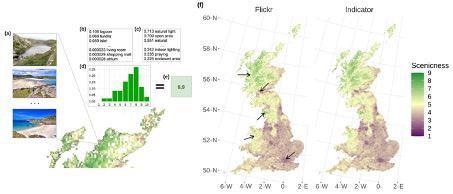The degree to which an individual takes interest in an outdoor activity — such as going for a run, hiking in the mountains, or paddleboarding — depends basically on the beauty of the immediate ecosystem. For example, landscapes that encompass rolling hills covered in yellow and lavender, a sparkling blue sea or a stream trickling across rocks can be an advantage to one’s mental and physical health.
 The model with Flickr and AI generates an overall measure of landscape aesthetic quality for each area. Image Credit: © Ilan Havinga (Photos Sergio and Graeme Churchard (cc-by/2.0)).
The model with Flickr and AI generates an overall measure of landscape aesthetic quality for each area. Image Credit: © Ilan Havinga (Photos Sergio and Graeme Churchard (cc-by/2.0)).
This sense of well-being is one of the aspects studied in ecosystem service (ES) evaluations, which measure the contributions of landscapes to the well-being of people so as to inform environmental policy.
To reinforce these evaluations, researchers from EPFL and Wageningen University have created a new type of model that employs artificial intelligence (AI) to integrate people’s aesthetic satisfaction with a landscape. Their model — based on nearly nine million pictures of British landscapes posted on Flickr — can be reproduced on a large scale since it uses data available on social media.
The model is the first to incorporate perceptions into how people appreciate landscapes at such a large scale while remaining as accurate as current approaches. Their research has been published in Scientific Reports, a Nature publication.
To create their model, the researchers trained a deep-learning algorithm on more than 200,000 photos of landscapes in Great Britain acquired from the Scenic-Or-Not database. These photos, containing a geographically illustrative dataset of Great Britain, were rated based on their aesthetic quality, or “scenicness,” via a crowd-sourced survey.
This method allowed the scientists to incorporate factors addressing how people enjoy landscapes individually — factors that have been overlooked in conventional large-scale ES evaluations. The researchers then tested their deep-learning model, which is based on neural networks, on more than nine million Flickr pictures, also combining other AI-based models in their predictions of picturesque beauty.
Lastly, they compared the output from their model with the outcomes of a more traditional, environmental indicator-based model.
A More Accurate Model
The researchers compiled their conclusions on maps of Great Britain with color codes representing the level of scenicness. Both models discovered that the Lake District in England, Snowdonia National Park in Wales and the Scottish Highlands were areas of predominantly high aesthetic value and well-being.
The results from the two models are roughly the same at a resolution of 5 km². They both also clearly identified urban areas like London and Glasgow as being less attractive.
Devis Tuia, Associate Professor, Environmental Computational Science and Earth Observation Laboratory, EPFL
However, at a resolution of 500 m², inconsistencies emerge and the Flickr model comes across as being more exact. For example, Richmond Park, Greater London and Heathrow airport are projected as being very picturesque areas by the conventional model, whereas the Flickr model more accurately categorizes them as absolutely un-scenic.
An Entirely New Way to Assess the Environment and How People Interact with it
Owing to the combination of deep learning and social media, the researchers’ model can also assess how people’s appreciation of the appealing quality of a landscape deviates over time. In a further experiment, the team examined natural park areas in Great Britain that are known for their extraordinary beauty, such as the Pembrokeshire coast in Wales, the Lake District and the Cairngorms in Scotland.
This experiment enabled them to analyze how appealing factors are connected to the seasons. The “snow” factor, for instance, aligns with weather reports during the same periods — the new model precisely presented the 2009–2010 winter as being predominantly snowy.
The researchers even noticed that the occurrence of “snow” increased close to the weekend when people were more inclined to visit snowy landscapes, while the occurrence of “asphalt” remained comparatively constant during the week.
“This indicates that the use of social media-based data provides a combination of information about the state of the environment and how people interact with it,” says Tuia. “Such information has never before been obtained with such a high degree of accuracy.”
It’s not easy to measure on a large scale how the aesthetic quality of a landscape contributes to people’s well-being. Our research provides a technology-based method for modeling people’s aesthetic enjoyment while incorporating the most important factor – the individuals themselves.
Ilan Havinga, PhD Student, Wageningen University
The subsequent step would be to test whether the model can be applied to other countries, given how diverse their cultures and landscapes can be. Researchers would have to discover a way to teach AI algorithms using locally applicable criteria.
Projects to that effect are already ongoing in Spain, The Netherlands and other European countries to aid environmental conservation policies throughout Europe.
Journal Reference:
Havinga, I., et al. (2021) Social media and deep learning capture the aesthetic quality of the landscape. Scientific Reports. doi.org/10.1038/s41598-021-99282-0.